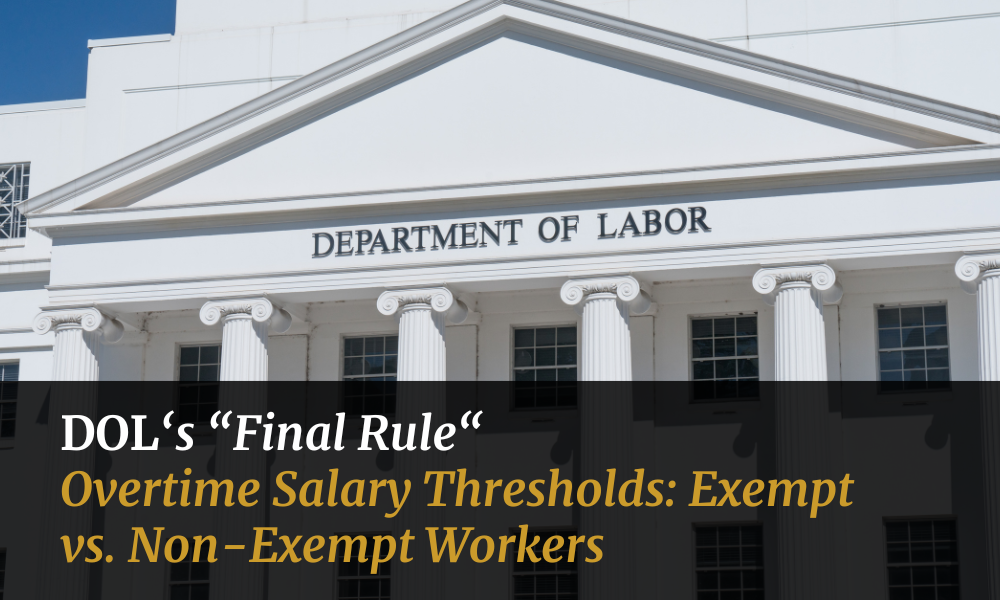Are you struggling to meet the new salary requirements outlined in the Department of Labor’s recent rule change? It’s been a month since the first increase took effect, and with another one on the horizon in January, it’s understandable if this transition has been challenging for both you and your employees. But don’t worry—we’re here to help.
As your staffing partners, our goal is to simplify complex legislation, ensuring you are well-informed about the rights and protections that impact your business. In May, we provided a comprehensive outline of the new rule, but we didn’t delve into what it means to be a “white collar” employee with exempt status.
Today, we’re breaking down the distinction between exempt and non-exempt workers in light of the final rule. Plus, we’ll share our recommendations for making this transition smoother for your business.
Exempt vs. Non-Exempt Workers
In April, the Department of Labor issued a final ruling on salary thresholds for workers who aren’t paid overtime. This rule primarily affects exempt workers, shifting those who don’t meet the new salary thresholds to non-exempt status. But what exactly does that mean?
Exempt Salaried Workers
Certain employees are exempt from the overtime pay rules outlined in the Fair Labor Standards Act (FLSA). These are salaried workers in executive, administrative, and professional roles (EAP) who earn a high enough salary that they aren’t required to receive extra pay for working more than 40 hours a week. The Department of Labor sets a fixed salary threshold that these workers must meet or exceed to be considered exempt. However, salary isn’t the only factor that determines exemption.
For example, let’s say you’re an Executive Assistant at a law firm, earning a salary of $52,000 per year. With the current salary threshold ($844/week or $43,888/year), you qualify as an exempt employee. But let’s also consider the administrative exemption test. According to the Department of Labor, your work must:
- Center around office or non-manual tasks directly related to the employer’s business operations
- Involve independent decision-making on significant matters
As an Executive Assistant, if you meet these administrative requirements, your employer isn’t required to pay you overtime for working over 40 hours a week. In summary, to be classified as an exempt salaried worker, you must meet two key criteria:
- Be paid a salary above the set threshold
- Pass the duties test for the relevant category (executive, administrative, professional, computer, outside sales)
Non-Exempt Workers
Workers who don’t meet these criteria are considered non-exempt and are subject to FLSA rules regarding overtime pay. This category includes:
- Salaried workers whose earnings fall below the threshold
- Hourly workers who don’t pass the duties test
Returning to our Executive Assistant example, if they pass the duties test, we then look at their salary. Currently, they are above the required threshold. However, in January 2025, when the threshold increases to $1,128/week ($58,656/year), they would fall below the cutoff, shifting them to non-exempt status.
Under this new rule, employers have three options:
- Increase their salary to meet the new threshold
- Switch them to hourly status to avoid exceeding 40 hours per week
- Maintain their salary but restrict them from working more than 40 hours per week
How LGC Can Help
If you find that some of your employees are being reclassified as non-exempt and need support, consider partnering with a staffing firm to ease the financial impact. Here’s how LGC can assist:
We understand the importance of retaining your skilled, salaried employees. Instead of extending their workweek beyond 40 hours, let us handle the coverage for any additional hours. You can rest easy knowing that we’ll manage the screening, recruitment, hiring, and more, ensuring a seamless staffing process. One of the greatest advantages of working with a staffing firm like LGC is the extra support, both literally and figuratively.
You’ll have more help where you need it—whether in the kitchen or another department—and we’ll take care of all employment aspects, including payroll, workers’ compensation, and resolving any issues that arise. It’s a win-win: you avoid paying overtime for your salaried workers and maintain full staffing.
If this scenario sounds familiar, you don’t have to navigate it alone. Give us a call, and we’ll help you find the right solution.
In other news…
Have you followed us on our social media?
To download our staffing app and more, check out our Linktree:
About LGC
Since 2003 LGC has been building connections between businesses with staffing needs and job seekers looking for new opportunities. Our range of solutions includes temporary and permanent placements (and everything in between) for a variety of industries. With offices located nationwide, we can tap into a dynamic pool of talented professionals. We have a passion for creating partnerships that last and work hard every day to ensure both clients and candidates reach their employment goals.





